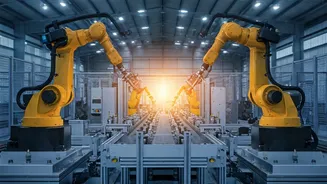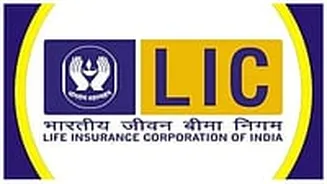Manufacturing's Significance
NITI Aayog's strategic vision places the Indian manufacturing sector at the forefront of the nation's economic progress, underlining its essential role.
The goal is clear: increase manufacturing's share of India's GDP to 25%. This strategic objective reflects a deep understanding of manufacturing's multiplier effects, including job creation, technological advancements, and the strengthening of the country's economic foundation. It recognizes that a robust manufacturing sector is not merely about producing goods, but also about driving innovation, promoting exports, and enhancing India's overall competitiveness in the global economy. By emphasizing the pivotal role of manufacturing, NITI Aayog sets a clear path for sustainable and inclusive economic growth, acknowledging that a thriving manufacturing sector can significantly contribute to transforming India into a developed nation. This forward-thinking approach provides a detailed framework for policymakers and stakeholders, ensuring the focus remains on the specific actions needed to achieve this ambitious target.
Strategic Policy Interventions
To realize the goal of elevating manufacturing's share to 25% of the GDP, NITI Aayog proposes a series of impactful policy interventions. These interventions are designed to stimulate growth, attract investment, and enhance the overall competitiveness of the sector. Crucially, these include streamlining regulations to eliminate bureaucratic hurdles and create a business-friendly environment that fosters entrepreneurship and innovation. Significant emphasis is being placed on infrastructure development, including upgrading transportation networks, ensuring reliable power supply, and developing industrial corridors. The objective is to reduce the costs of doing business and to facilitate the efficient movement of goods and services. Furthermore, these policies include incentives for research and development (R&D) and promoting the adoption of advanced technologies, all of which are essential for boosting productivity and keeping up with global standards. Skill development initiatives, aimed at creating a workforce equipped with the modern skills needed for manufacturing jobs, form a key component of this strategic approach. This holistic, multifaceted approach makes sure that the growth of manufacturing is sustained by strong economic fundamentals and supports the country's long-term vision for economic prosperity.
Infrastructure Development Focus
Infrastructure development is a fundamental pillar of NITI Aayog's strategy, recognizing its crucial role in accelerating the growth of the manufacturing sector. The plan calls for significant investments in multiple areas, each designed to boost efficiency and competitiveness. One key area is the development of robust transportation networks, including well-maintained roads, railways, ports, and airports, as this is essential to facilitating the seamless movement of raw materials and finished products, and to reducing transit times and logistics costs. Secondly, NITI Aayog underscores the importance of a dependable and efficient power supply. This is crucial for sustaining the smooth operation of manufacturing facilities and for attracting new investments. Furthermore, industrial corridors, planned areas with integrated infrastructure and focused industry clusters, are being promoted. The aim is to concentrate economic activity, boost productivity, and generate economies of scale. These efforts together, serve to cut operating costs, enhance productivity, and boost India's attractiveness as a prime location for manufacturing investments, creating the conditions for sustained expansion and economic growth.
Job Creation and Skills
The growth of the manufacturing sector, as envisioned by NITI Aayog, is closely linked with the creation of new employment opportunities and the development of a skilled workforce. As manufacturing activity expands, there will be increased demand for a diverse range of skilled professionals. This includes engineers, technicians, and skilled workers proficient in areas such as automation, digital manufacturing, and advanced production techniques. To meet this demand, NITI Aayog plans to implement comprehensive skill development initiatives. These initiatives are focused on providing vocational training programs, upgrading existing skills, and ensuring that the workforce is equipped with the latest competencies needed to succeed in a modern manufacturing environment. Collaboration between the government, industry, and educational institutions will be essential to tailor training programs to meet industry-specific needs and to align the training with advancements in technology and industrial practices. The aim is to create a dynamic ecosystem that produces a ready supply of skilled workers to support the growth of the manufacturing sector, thus fostering economic growth and improving the quality of life for millions of Indians.
Fostering Innovation and R&D
To make India a global manufacturing powerhouse, NITI Aayog places great emphasis on promoting innovation and investing in research and development (R&D). This strategic approach is meant to cultivate a culture of innovation, driving technological advancements, and supporting the development of cutting-edge manufacturing processes and products. Incentives for R&D are designed to encourage businesses to invest more in these crucial areas. This can include tax benefits, grants, and support for collaborative research projects between industry, academia, and government organizations. NITI Aayog also promotes the adoption of advanced technologies such as artificial intelligence, the Internet of Things (IoT), and automation, with the aim of boosting productivity, improving product quality, and improving efficiency throughout the manufacturing value chain. Furthermore, the plan encourages the creation of centers of excellence and incubators to foster innovation and facilitate the transfer of technology from research institutions to manufacturing operations. This comprehensive strategy creates a dynamic and competitive manufacturing environment that will support India's long-term goals for economic growth and technological leadership.
Global Competitiveness Enhancement
Enhancing India's global competitiveness is a key aspect of NITI Aayog's strategy to boost the manufacturing sector. This includes measures aimed at improving the ease of doing business, reducing trade barriers, and supporting the integration of Indian manufacturers into global value chains. Streamlining regulatory processes and reducing bureaucratic hurdles are meant to lower the costs of doing business and encourage both domestic and foreign investment. Simultaneously, the government is working to negotiate favorable trade agreements and to remove tariffs and non-tariff barriers that impede international trade. This is intended to open up new markets for Indian-made goods and services. A strong focus on quality control and standardization is essential to ensure that Indian products are competitive in international markets. This would involve the enforcement of quality standards and certification, the promotion of brand building, and investments in infrastructure that supports global trade, such as port facilities and logistics networks. The goal is to position Indian manufacturing as a reliable and high-quality provider of goods and services on the global stage, contributing to economic growth and attracting significant investment.















